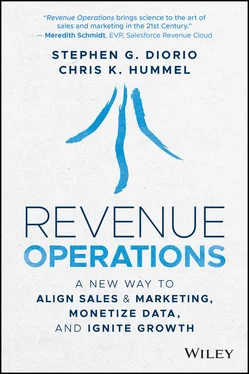Stephen Diorio - Revenue Operations
Здесь есть возможность читать онлайн «Stephen Diorio - Revenue Operations» — ознакомительный отрывок электронной книги совершенно бесплатно, а после прочтения отрывка купить полную версию. В некоторых случаях можно слушать аудио, скачать через торрент в формате fb2 и присутствует краткое содержание. Жанр: unrecognised, на английском языке. Описание произведения, (предисловие) а так же отзывы посетителей доступны на портале библиотеки ЛибКат.
- Название:Revenue Operations
- Автор:
- Жанр:
- Год:неизвестен
- ISBN:нет данных
- Рейтинг книги:3 / 5. Голосов: 1
-
Избранное:Добавить в избранное
- Отзывы:
-
Ваша оценка:
- 60
- 1
- 2
- 3
- 4
- 5
Revenue Operations: краткое содержание, описание и аннотация
Предлагаем к чтению аннотацию, описание, краткое содержание или предисловие (зависит от того, что написал сам автор книги «Revenue Operations»). Если вы не нашли необходимую информацию о книге — напишите в комментариях, мы постараемся отыскать её.
Revenue Operations: A New Way to Align Sales and Marketing, Monetize Data, and Ignite Growth
Revenue Operations
Revenue Operations
Revenue Operations — читать онлайн ознакомительный отрывок
Ниже представлен текст книги, разбитый по страницам. Система сохранения места последней прочитанной страницы, позволяет с удобством читать онлайн бесплатно книгу «Revenue Operations», без необходимости каждый раз заново искать на чём Вы остановились. Поставьте закладку, и сможете в любой момент перейти на страницу, на которой закончили чтение.
Интервал:
Закладка:
2 Creating a burning platform to redefine the customer experience. From a marketing standpoint, over 80% of CMOs viewed the pandemic as a big opportunity to redefine the customer experience in digital and virtual channels and change the way they reach and engage customers (e.g. media mix, channels). This sentiment is being reflected in the way CMOs are reallocating their budgets in the recession. For example, 81% of traditional businesses are increasing investment in digital technologies to improve market coverage and client engagement. 5
3 Accelerating the adoption of advanced communications, enablement, and visualization technologies. From a technology perspective, the pressure to adapt to this new buying reality is accelerating the adoption of existing but grossly underutilized technologies that offer the potential to multiply seller performance. These include algorithmic selling, sales enablement, 5G communications, direct-to-consumer (DTC) channels, and even augmented reality. Properly designed and equipped, virtual selling channels can dramatically improve the coverage, control, and cost-effectiveness of sales channels while offering buyers the speed of response and experiences they demand.
4 Creating massive new customer and seller activity data sets. “An explosion of sales engagement data has become available to analytics teams in the past 24 months,” according to Len Ferrington, a managing director of Summit Partners. “This data is coming from first party systems, email, calendars, third party sources, recorded sales conversations (via Zoom, Teams or transcripts) and contactless selling platforms (like text and chatbots).” 159The number of recorded sales calls has gone up thirtyfold since the start of the pandemic.
5 Elevating the importance of analyzing customer sentiment and nonverbal cues. “The rapid growth of virtual selling is creating a need for AI and analytics that inform the EQ of selling to help sales reps better understand customer sentiment, response, and relationships in the absence of face-to-face conversations,” reports Professor Iyengar of Wharton. 18“Businesses will need to find ways to use new data from customer transcription and digital engagement platforms like Zoom, Teams, or Cisco Webex to understand customer emotions and all the non-verbal elements of selling.”
6 Forcing sales operations to improve visibility and transparency. Gaining access to real-time commercial insights into account health, opportunity potential, seller, and pipeline performance are now essential to managing the performance of digital, displaced, diverse, and dynamic revenue teams. These are regarded as the top drivers of remote sales productivity by sales managers and performance professionals.
Twentieth-Century Tools Are Obsolete
Each of these forces has disrupted the status quo in marketing, sales, and service. Collectively, they have made traditional notions of how to manage growth obsolete. Managers try to manage revenue teams and activities that require a far more advanced and digital selling model than the systems and tools developed in the twentieth century can provide.
Using an obsolete commercial model to manage a modern selling infrastructure has significant business consequences. Managing marketing, sales, and service resources as discreet functions is an obstacle to teamwork. The idea of a linear and orderly customer journey – with advertising in the front, selling in the middle, and service and support at the end – just doesn't work because customers don't buy that way. The historic reliance on traditional print advertising and in-person human selling as pillars of investment for marketing and sales sharply declines as the number of customers who prefer to buy online increases.
The financial consequences of relying on a commercial model developed in the last century to manage a twenty-first-century selling system are large. For example, the uncoordinated management of the revenue cycle leads to revenue and margin leaking through “air gaps” and handoffs in the customer journey. Organizations can leak 10 percentage points of EBITDA by failing to follow up on opportunities, enforce pricing discipline, respond to buying signals, or recognize when their biggest customers are about to take their business elsewhere. The disconnected management of the valuable technology, customer data, and digital infrastructure assets that support revenue growth can create even bigger financial problems. If you don't have a coherent system for curating and connecting these growth assets into selling outcomes that create value, the result will be lower than acceptable financial returns on investment and higher selling costs. Managing these valuable growth assets in many different functional silos is the equivalent of racing an expensive car that is not firing on all cylinders and needs a wheel alignment and a tune-up.
Management models have always evolved with economic and market change. The corporation, conglomerate, and business unit structures pioneered by Rockefeller (Standard Oil), Reginald Jones (GE), and Alfred Sloan (GM) respectively were all structural innovations that served their purpose in their time.
The world has changed. Dramatically. The “stovepipe” organization consisting of separate marketing, sales, and service functions is a vestige of another era when media had greater reach, digital channels were just emerging, and customers followed an orderly and linear buying process. The CMO role emerged when business could get by with a big media budget to drive demand. The VP of sales when managing “sellers” was the key to closing deals. Roles like sales operations, customer insights, and digital marketing did not even exist 25 years ago because digital technology and customer data were not key components of the selling formula.
The Role of Leadership
The leadership model for managing growth resources is similarly outdated. For example, the Chief Marketing Officer (CMO) is a job function built on big brands and TV budgets that has only existed for a few short decades. But those big media budgets have been in decline for years. This has left many CMOs struggling to find a seat at the table as their core budgets have eroded and fighting from being pigeonholed at the very front of the revenue cycle. Large field sales organizations like the famous IBM “Blue Suits” have been around a long time, but the selling function has evolved by adding multiple tele, social, web, and even contactless channels that don't necessarily need a field sales force to serve customers. Service has become far more elevated and strategic as product adoption and experience have become central to customer relationship building, revenue expansion, and customer lifetime value.
Today, the functional distinctions between marketing, sales, and service exist more because of cultural and operational inertia rather than market reality. The silos that manage these roles have become a political and operational necessity to keep the machine running and cash flowing in the short term. These silos have also led to dysfunction and waste. Strategically, the hard functional structures represent a boat anchor that holds back revenue growth in the twenty-first century by impeding horizontal information flow across the revenue cycle and by making it difficult to deploy technology as a force multiplier at scale.
The twentieth century commercial structure is collapsing under the twin pressures of changing customer behavior and shifting business models. “Organizations are going to need to rewire their commercial engines to better reflect the new buying reality where customers are channel agnostic and buyer behavior is non-linear,” reports Brent Adamson, distinguished Vice President in Gartner's Sales practice. 129“It's a big job. It's going to involve reworking the legacy commercial infrastructure, and creating new roles, processes and metrics.”
Читать дальшеИнтервал:
Закладка:
Похожие книги на «Revenue Operations»
Представляем Вашему вниманию похожие книги на «Revenue Operations» списком для выбора. Мы отобрали схожую по названию и смыслу литературу в надежде предоставить читателям больше вариантов отыскать новые, интересные, ещё непрочитанные произведения.
Обсуждение, отзывы о книге «Revenue Operations» и просто собственные мнения читателей. Оставьте ваши комментарии, напишите, что Вы думаете о произведении, его смысле или главных героях. Укажите что конкретно понравилось, а что нет, и почему Вы так считаете.











